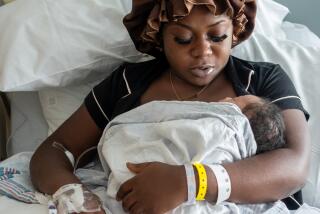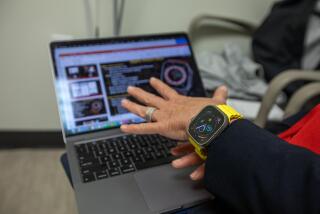Computer Umbilical Lines Keep Doctors in Touch With Mothers and Fetuses
- Share via
The drama that flashes across Dr. Daryl P. Alexander’s video screen every day has no script. But Alexander knows the lines anyway.
They zigzag across a graph, tracing the heartbeat of fetuses and charting the contractions of mothers-to-be who are resting in a hospital maternity ward down the street.
Alexander is a Tarzana obstetrician who can tell at a glance from the screen in her office whether the labor is normal--or whether she should drop what she’s doing and rush to the hospital to be at the mother’s side.
Her office video screen is connected to a simple home computer that has been programmed to decipher coded signals on vital signs sent by telephone from the Tarzana Regional Medical Center to her office.
Alexander and her partner, Dr. Milka C. Torbarina, are the first physicians in the San Fernando Valley to use the new remote fetal monitoring system, which is connected to conventional bedside equipment at the hospital’s eight-bed maternity ward, medical experts said.
Medical experts say the device gives obstetricians instantaneous information about a patient without the doctors having to be to be at the hospital or having to rely on a hurried phone conservation with an obstetrics nurse.
Doctors say fetal phone monitoring may be quick to catch on and expand.
“I think it would be valuable, a real advantage to us,” said Dr. Jack Galloway, a Van Nuys obstetrician who has heard about the system but hasn’t seen it.
Besides the Tarzana hospital, medical centers in Orange, Arcadia and Irvine and in New York and Canada are now using the equipment.
“I’d like to see the day come when women can hook up at home for a test. With today’s technology, it shouldn’t be long,” said Galloway, who delivers about 10 babies a month at Valley Presbyterian Hospital.
“It’s like being at the hospital,” said Alexander, who plugged her office into the system earlier this month as part of a test by the Tarzana hospital. “There are going to be cases where this will save lives.”
Torbarina said the device is already saving time.
“In the past, we’d often have to leave an office full of other patients to go to the hospital when a nurse called, only to find when we got there that the patient’s tracings were normal,” Torbarina said.
Doctors say that tracings--the squiggly heartbeat and contraction lines resembling a seismograph chart during an earthquake--are their most important clues to the health of a baby about to be born.
Hospital fetal monitors are particularly valuable for so-called high-risk pregnancies, such as among the growing number of first-time mothers older than 34, experts say.
The heartbeat line shows the condition of the fetus, and the contraction line shows how soon the delivery will occur.
“If you see a bad tracing, where the heartbeat’s down but where the mother has only dilated 3 centimeters and the baby could be 12 hours away, you know to take action,” Alexander said.
On the basis of what the tracings show, doctors can add medication to increase contractions and speed up the process or schedule a Caesarean section operation, she said.
It’s a Time-Saver
The fetal phone monitor can save about 15 minutes a consultation--a potentially crucial amount of time to a fetus in distress, said Lynne Gordon, manager of the maternal-fetal medicine department at the 212-bed Tarzana hospital.
That is the amount of time it typically takes a physician to travel to the hospital from his office to view a tracing. It takes a similar length of time for a nurse to send a facsimile copy of a fetal monitor printout by telephone to a physician, Gordon said.
At the end of a pregnancy, time is important because problems can develop rapidly, Gordon said. “The cord can become wrapped around the baby’s neck, or the baby can move into the wrong position. It can happen very quickly,” she said.
The 24-nurse maternity staff doesn’t mind the doctors peering electronically over their shoulders, said the ward’s head nurse, Sue Moyer.
“Most nurses are experts at reading fetal monitors, but sometimes it’s just reassurance to know that doctors are watching, too,” she said. “But I’d be real embarrassed if a doctor was watching and spotted something we didn’t.”
Tarzana’s experimental computer system was set up by Dr. Barry Schifrin, the hospital’s director of maternal-fetal medicine. He said he has long had a personal interest in computers.
Schifrin said the computer monitoring network gives nurses access to doctors who are prenatal experts. Such experts may be able to identify fetal monitor tracings that look dangerous, but are not, in time to avoid an unnecessary emergency Caesarean section, he said.
“Fetal monitors have been around for a while in hospitals, but there aren’t enough people with experience in reading them to go around,” Schifrin said. “Not everyone can make maximum value of the machine.”
Besides allowing local doctors to keep tabs on their maternity patients from afar, the computer hookup will eventually allow doctors at small or outlying hospitals to consult experts, he said. The computers’ disks will also permanently record the fetal tracings in case of legal questions about a pregnancy, Schifrin said.
Equipment and software used to convert signals from bedside fetal monitors for computer use were developed by Dr. Kee Koh, an Arcadia obstetrician. Koh said he worked with computer engineers from California Polytechnic University, Pomona.
His next step is to modify his “Peritronics” system to work with lap-top portable computers that can be plugged into pay phones or portable cellular telephones.
For doctors who might want to keep tabs on patients from the golf course on Wednesday afternoons, that would be a real labor-saving device.
More to Read
Only good movies
Get the Indie Focus newsletter, Mark Olsen's weekly guide to the world of cinema.
You may occasionally receive promotional content from the Los Angeles Times.










